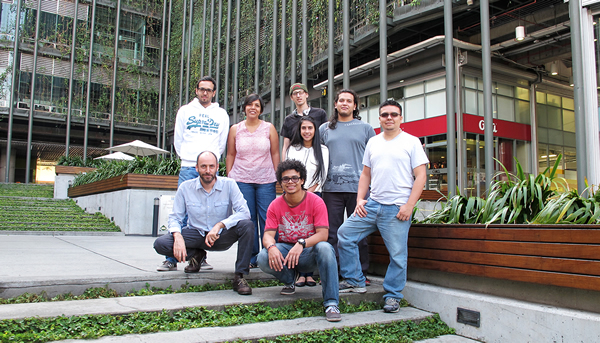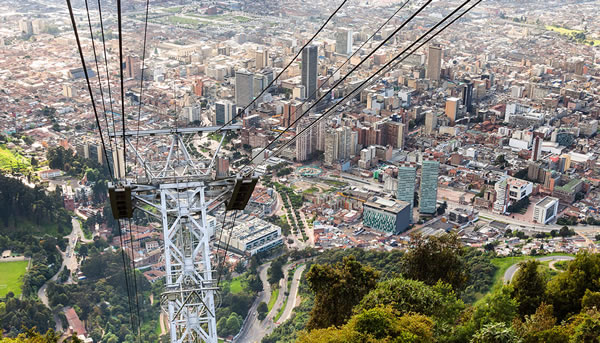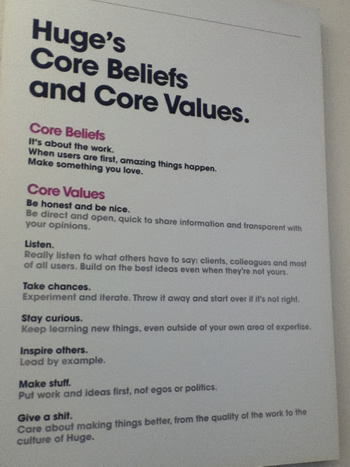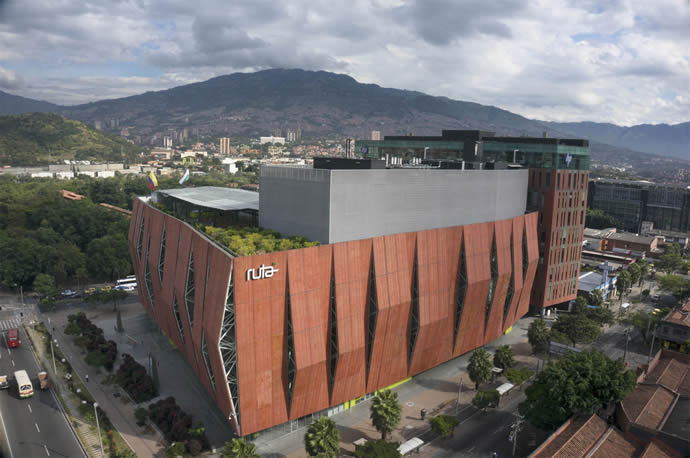“Make something you love.”
That’s just one of the three core beliefs of Huge, the Brooklyn-based creative agency that’s part of Interpublic Group. It could just as easily be the core mission of Medellin, Colombia.
The city of 1.2 million, in the deep Aburrá Valley in the Central Andes state of Antioquia, carries a name tainted by years of narco-violence and poverty. But it’s turned over a new leaf with a mission that’s equal parts economic development and social inclusion. And it’s where Huge’s brand new office, established earlier this year, is already expanding.
Huge has worked with such companies as Diageo, Nike, Gucci, GE, Samsung, Lexus, Fat Face, Pfizer, Eurosport, Four Seasons, TED, Hublot and HBO to create products, websites and entire brands. Huge’s footprint, like its high-end customer base, extends well beyond Brooklyn, where the firm was founded in 1999. The firm today also has offices in Atlanta; Bogota; Washington, D.C.; London; Los Angeles; Oakland; Portland, Ore.; Rio de Janeiro; Singapore and Toronto. Since 2011, the agency has grown from 500 to more than 1,000 employees.

Overseen by native Belgian Peter Van Dijck, the Huge team in Medellin provides engineering and design services. Earlier this week, the company had nine job openings it was looking to fill in Bogota, and another seven in Medellin. But the Medellin plan is much bigger than that, says Van Dijk in an interview in Huge’s office, located at the Ruta N building, a striking LEED-Gold structure in the heart of the city’s “Medellinovation” District.
The growth opportunity offers further illustration of Medellin’s alignment with Huge’s core values, two of which are “Be honest and be nice,” and “Take chances.”
Medellin and national officials took a chance a few years ago in luring a $14-million global services center to Ruta N from Hewlett Packard, which anticipated creating 1,000 jobs. But corporate restructurings can be as messy and feral as any developing-world alleyway. HP’s global refresh has meant pulling out of an operation that had barely launched.
So Huge, which itself just launched mere months ago, will be moving into some of the former HP space, and is ratcheting up its job creation goal from its current headcount of 30 to at least 90. The firm’s Bogota office employs 30.

“We are already full,” says Van Dijk of the bustling Medellin workspace. “The size of the office is limiting work. So we are moving into new space on the seventh floor of the building across the courtyard that will fit 65 people.”
According to Catalina Castano, director of operations at Ruta N, two of the complex’s three towers are at 100-percent occupancy, as the incubator/accelerator organization approved 33 new denizens in 2014 as part of its “Landing” strategy, and already has approved 19 more this year from among 31 more applicants. Entities range from videogame developers to major multinationals to Purdue University’s first office outside the US. A total of 70 companies from 15 countries (including 26 from Colombia) have landed, generated 1,200 new jobs for the city.
The third eight-floor tower includes three floors leased to HP Holcrest, a subsidiary of Swiss multinational cement company Holcim, which employs 450 people in a financial shared services center that serves six Latin American countries. The company reached a sublease agreement in 2013 with HP, which currently continues to employ 100 in an office occupied by its BPS Americas operation.
Huge will occupy another of the former HP floors, while three-and-a-half floors that are still leased to HP today will be made available as new companies come on board.
Rigorous Review
Castano knows something about making innovation grow as robustly as her home region’s famous orchids. She also knows something about the borough Huge calls home. Two years ago, she returned to Medellin after 12 years in New York City, where, as the regional director of the Brooklyn Small Business Development Center (SBDC), she helped that organization win a US Small Business Administration award for being the most innovative SBDC in its region.
“It’s a completely different picture from when we left in 1999,” she said last week. “Coming from the ecosystem in New York City, I can tell you we are going in the right direction. Our mission is being a world-class ecosystem. We have the right ingredients, and still have to work on the recipe.”
“I have a history with Medellin, and since 1999 it’s changed dramatically,” agrees Huge’s Peter Van Dijk, who was joined via videoconference from Brooklyn by Gela Fridman, the Russian-born group vice president, technology, for Huge.
“Colombia is interesting to us because of the time zone [equivalent to US Central Time] and the agile work style,” says Fridman, who joined Huge three years ago. “Being in the same time zone was important.” So were personal connections that included two Colombians in the company’s Brooklyn office. “We are focusing on key locations to build engineering studios in Brooklyn, Atlanta, Bogota and Medellin.”

The company’s hiring process is as comprehensive as its holistic approach to clients.
“When hiring we are looking for a couple of things,” says Fridman. “Someone who is solution-oriented, with strong English skills, who knows how to use high tech, is agile and used to fast-paced delivery.”
“We are thorough, and only go for the best,” says Van Dijk, noting that the majority of Medellin hires are from the region, with a quarter from Greater Bogota. “We interview more than 10 people for every hire we make, and that means multiple interviews. They write codes, we review, and they talk to our people in the US.”
Raj Singhal, Huge’s CFO, is a former mechanical engineer at Ford Motor Co. who oversees the company’s global financial operations, including IT, real estate, financial planning and M&A. Asked how his team has approached site selection for Huge’s latest salvo of new offices in Medellin, Singapore and Toronto, he says, “Our international expansion efforts are based on an overall long-term strategic plan to do great work at scale. To achieve this, we look for the best digital designers, developers and strategists in the world. We chose to open offices in Singapore, Medellin and Toronto, as we found great talent in those locations. Once we decide to open up an office, our operations and real estate teams look for space located somewhere truly convenient for employees, where we can grow rapidly and sustainably over time.”
Singhal says the cost delta between Medellin and Bogota “isn’t significant, but Colombia’s tax structure is more favorable than some other countries in the region, which is one of the reasons we chose to invest in our offices there.” Asked whether getting in and out of the steep valley and the airport 50 minutes away presents a challenge, he says, “In this day and age, transportation is not a significant issue. Medellin has a very effective metro system, and going between Medellin and the US is easy with daily flights from NYC.”
Setting the Bar
The company is not bashful about travel, as it frequently shuttles staff among its 11 offices as it serves global clients with high-end work by small, focused teams. Most of the clients are based in the US, with others based in London or Brazil. Asked how cost plays into the Medellin equation, Fridman says, “Cost is not part of the value proposition. Our focus is on quality, not cost.”
“It has never been about being cheaper, though clearly it is,” says Van Dijk. “We can hire the best engineers. I believe we are the coolest company in Medellin — and even in the country — to work for. In New York, we’re one of the coolest.

“One of our main motivations is to bring a level of quality to Medellin,” he continues. “We are setting a bar, a bar not typically seen here. We ask people to do it, and they do it, and they’re good. We can bring up everybody’s level.”
The 4,500 sq. m. (48,440 sq. ft.) devoted to “Landing” at Ruta N are part of a larger innovation district plan encompassing an eventual 1.5 million sq. m. (16.1 million sq. ft.) of built space, part of a goal of seeing innovation-minded companies there represent 2 percent of Antioquia’s GDP by 2018 (they’re at 0.75 percent today). A total of 1,800 companies have signed on to the Mellinovation Pact. “The country even wants us to implement the pact in other cities,” says Castano.
Ruta N is focused on nurturing energy, health and ICT firms. The city it calls home — known as the “City of Eternal Spring” because of its climate — is focused on serving as a bubbling spring of knowledge-economy prosperity. Medellin, which will host the Cities for Life Global Meeting in late August, was named by The Wall Street Journal and Citi in March 2013 as the most innovative city in the world, beating out finalists New York and Tel Aviv based on 980,000 online votes cast in the “City of the Year” competition conducted in partnership with the Urban Land Institute.
“Medellín stands today as an example for many cities around the world, because despite having lived very dark and difficult times 20 years ago, we have been undergoing a true metamorphosis,” said Mayor Aníbal Gaviria then. “Going from pain and fear to hope, and now from hope to be a place filled with life, the city has known how to innovate in every step, both in social programs, urban developments, or the combination of both, and this has been key in the success of this process.”
Swimming in Services
Look at a map of Colombia, color-coded by its 32 regional departments, and the first image that springs to mind is an angelfish, always chasing down the sun. A look at economic and demographic indicators points to at least catching hold of a bright future:
- It is the second-largest Spanish-speaking country in the world and among the 30 most populated, with 48 million people, as of 2015. (No. 1 Mexico has nearly 121 million, while No. 3 Peru has just under 32 million.)
- Fifty-five percent of the Colombian population is less than 30 years old.
- There are nine cities with over 500,000 people each.
- The country boasted more than 400,000 graduates and specialists in engineering-related areas between 2000 and 2011.
- There is an available labor force of more than 1.2 million professionals graduated in fields related to financial and value-added shared services operations.

Juan Carlos Gonzalez, vice president of foreign investment for ProColombia, says shared services is indeed a sweet spot, as Colombia seeks to capitalize on the trend of shared services consolidation in one country. AIG recently centralized operations for the region in Bogota, for instance. “It’s an important area of interest for us,” he says. “You can create good, high-level jobs quickly.”
Juan Carlos Jimenez, investment promotion manager for Invest in Bogota, says AIG, which has operated in Colombia for 80 years, considered Mexico City and Sao Paulo before choosing his city, where an initial hiring goal of 500 already has bloomed to nearly 1,000 staff.
Even in the face of rein-tightening brought about by lower oil and gas and mining tax revenues, the national government continues to broadcast new policies aimed at diversifying the economy away from that resources-based economy. Early this month, the government approved new tax benefits for science, technology and innovation, as it seeks to increase the number of innovative companies by 30 percent by 2018.
Broadband connections in Colombia increased from 2.2 million to 8.8 million between 2010 and 2014, and are forecast to triple over the next four years.
In late June, as part of an effort to increase exports of services by 30 percent over the next four years, a new “Colombia Exports Services” strategy was unveiled by Minister of Trade, Industry and Tourism Cecilia Alvarez-Correa and Deputy Minister of Foreign Trade Mariana Sarasti Montoya. It aims for services exports to grow from US$6.7 billion in 2014 to $9 billion in 2018.
Such measures combine with infrastructure and broadband investments made over the past four years to do one important thing for companies seeking a market and citizens seeking a living, says Colombian Minister of Finance Mauricio Cardenas.
“A number of investments in the past four years will provide a very important dividend in the future,” he says. “They help by widening our middle class. The number of people lifted out of poverty now is 4.5 million, and [with] investments in telecom, broadband is in 1,100 municipalities of Colombia now.”
ProColombia’s Juan Carlos Gonzales confirms that the poverty level in Colombia has fallen from 50 percent as recently as 2002 to 28 percent last year, with extreme poverty falling from 18 percent to 8 percent. Meanwhile, the middle class grew from 16 percent in 2002 to 31 percent in 2013, the year it finally surpassed the poverty percentage. Projections call for the Colombian middle class to grow from 11.6 million in 2012 to 19 million in 2020 and 24.7 million in 2025.

“That is one of the reasons companies come to Colombia,” Gonzales says “It’s the third largest country in Latin America after Brazil and Mexico. The average real growth of consumer expenditure from 2014 to 2018 is projected to be 4.7 percent. And more and more young people want to go to their own cities, not have to go elsewhere.”
That last trend is certainly on the minds of the teams at Ruta N and its colleagues at ACI, Medellin’s inward investment agency.
“There are lots of services you can develop and test here,” says Catalina Castano, to reach a large market in Colombia and scale to the rest of the world. “Medellin makes a great laboratory for those types of projects.”
All while it continues to serve as a lab for urban renewal and social inclusion on a grand scale. Substitute “citizens” for Huge’s favorite word for customers, “users,” and it brings you right back to the company’s other two core beliefs:
“It’s about the work” is one. “When users are first, amazing things happen” is the other.
Medellin and Colombia hope a focus on the needs of innovative companies makes more work and more amazing things happen for its citizens.
“Everybody’s excited about the years to come,” says Huge’s Van Dijk of the opportunity beckoning to both his company and its newest home.

